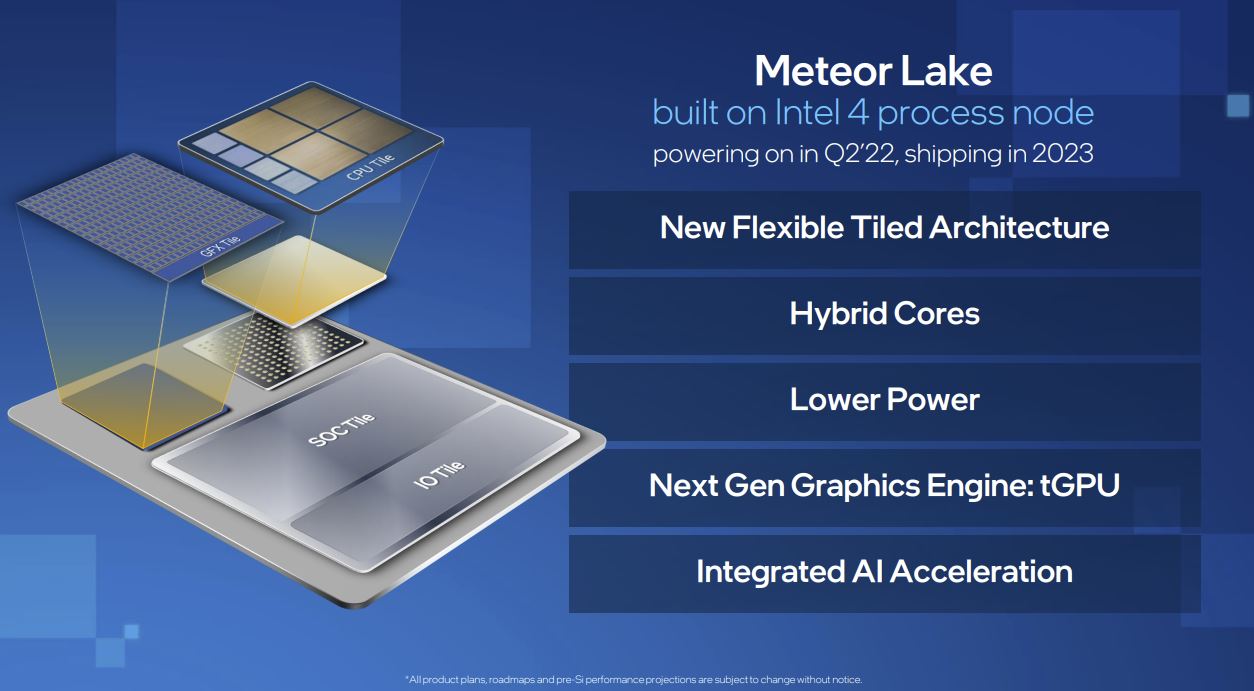Intel Ships Meteor Lake CPUs to PC Makers

On a earnings calls (transcribed via Seeking Alpha) Intel announced on Thursday that it had begun shipments of its 14th Generation Core 'Meteor Lake' processors to PC makers. The multi-tile CPUs are set to be officially launched on December 14, but they have been in mass production for quite some time and the company has been shipping for weeks now.
"In Q3, we began initial shipments of Meteor Lake on Intel 4, which we are now aggressively ramping on the most productive fleet of EUV tools in the industry, providing us with a greater than 20% capital efficiency advantage, compared to when EUV tools were first launched," said Pat Gelsinger, chief executive of Intel, at the company's earnings call. "The Intel Core Ultra has been shipping to customers for several weeks and will officially launch on December 14 alongside our 5th Gen Xeon."
It is noteworthy that Intel is producing key silicon for its Meteor Lake processors — its compute tile — on Intel 4 process technology (previously known as 7nm, the company's first production node to use extreme ultraviolet (EUV) lithography) at two fabs. One is located near Portland, Oregon, another is near Leixlip, Ireland. Using two fabs to produce components will ensure that Intel will make sufficient volume of Meteor Lake CPUs.
"High volume EUV manufacturing [of Meteor Lake] is well underway in Oregon and more recently in Ireland," said Gelsinger. "Our Fab 34 in Ireland represents the first high volume EUV production in Europe, underscoring our commitment to establish geographically diverse and resilient supply."
Intel's Meteor Lake will be the company's first multi-tile processor for client PCs. The CPU is set to comprise of four tiles connected using Foveros 3D packaging technology (so, one can think of this design as a five-tile architecture since the base die is also made in a clean room): a compute tile packing Ocean Cove high-performance CPU cores, energy-efficient Gracemont cores, an AI accelerator, a graphics tile featuring a GPU based on Intel's Xe-LPG architecture, an SoC die integrating such things as a memory controller, a PCIe controller, and a Thunderbolt controller, and an I/O tile.
Intel expects its Meteor Lake processors to offer unprecedented level of performance efficiency and set the stage for a new class of PCs featuring built-in generative AI acceleration.
Get Tom's Hardware's best news and in-depth reviews, straight to your inbox.

Anton Shilov is a contributing writer at Tom’s Hardware. Over the past couple of decades, he has covered everything from CPUs and GPUs to supercomputers and from modern process technologies and latest fab tools to high-tech industry trends.
-
Reply
(so, one can think of this design as a five-tile architecture since the base die is also made in a clean room): a compute tile packing Ocean Cove high-performance CPU cores, energy-efficient Gracemont cores, an AI accelerator
Nope. The chip will utilize the brand-new Redwood Cove architecture for its P-Cores and the Crestmont CPU architecture for its E-Cores.
Redwood Cove (P-Cores)
Crestmont (E-Cores)Not sure from where you got Ocean Cove and Gracemont as the core's codename. Gracemont was used in previous gen of chips.
MTL lineup also sports an additional E-core cluster located on the SoC tile, sporting the Low Power Island E-cores/LPE, which is based on the same "Crestmont" core architecture as the E-cores on the Compute tile although not being part of its ringbus or sharing its L3 cache. But this E-core cluster has its own L2 cache shared among four cores. -
thestryker It sounds like Crestmont should be an all around improvement, but Redwood Cove is mostly efficiency rather than performance. Will be interesting to see what these look like in the wild even if we're only getting laptop CPUs.Reply -
ReplyLucky_SLS said:Wasn't there rumours that we would get the desktop meteor lake chips in 2024?
Those were just "unverified" rumors. The plan has been scrapped now in favor of Arrow Lake-S desktop chips instead. No more desktop chips on the LGA 1700 platform.
They will release only for Notebooks and AIOs (BGA chips, i.e. soldered notebook solutions, incldung some NUCs).
As per Intel, Meteor Lake is purely a notebook product, and the "classic" desktop PC is not the goal of the company. Just mini PCs and all-in-one systems that typically use mobile chips rather than socketed processors (in the ball grid array (BGA) format).